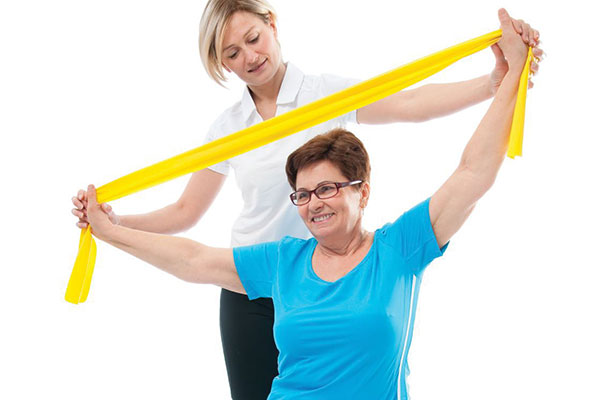Cancer Rehabilitation
Helping You Recover after Cancer Treatment
by Sean Smith, MD
A cancer diagnosis is oftentimes a serious, life-threatening event. As such, medical research and treatment has traditionally – and rightfully – focused on curing and preventing the disease. Unfortunately, because of this strict focus on eradicating the cancer, the side effects of cancer treatments are often overlooked or underdiagnosed, leading to unnecessary pain and distress for cancer survivors. Side effects like pain, neuropathy, muscle weakness, chemo brain, and fatigue affect nearly every person with a history of cancer, and they can significantly disrupt a cancer survivor’s quality of life, including their ability to spend meaningful time with family and friends or return to work.
The good news is that these side effects are all potentially treatable once they are identified. And a medical specialty that aims to help people navigate both the early and late effects of cancer and its treatment – and improve their quality of life – is gaining traction in the U.S. It is called cancer rehabilitation.
Cancer rehabilitation medicine is a subspecialty of physical medicine and rehabilitation – a medical specialty originally created in the early twentieth century to help people with disabilities, namely polio survivors and injured veterans returning from war. The specialty has evolved to incorporate a variety of impairments, from sports-related injuries to paralysis stemming from a car accident. With cancer rehabilitation, medical specialists focus on treating the various side effects and impairments that arise due to cancer diagnosis and treatment. Cancer rehabilitation may include physical and occupational therapy, speech-language pathology, psychology, and other specialties that help restore a person’s function and quality of life after undergoing cancer treatment.
Impairment-Driven Cancer Rehabilitation
People with a history of cancer experience a wide variety of symptoms and side effects, which can be challenging for both the survivor and their oncologist. Cancer rehabilitation can help survivors manage these problems by focusing on specific issues and developing an action plan for each. This is called impairment-driven cancer rehabilitation.
Here’s an example: A woman who has been treated for breast cancer with a mastectomy, radiation therapy, and chemotherapy, and who remains on an aromatase inhibitor (a medication that decreases estrogen production) may experience shoulder pain, as well as pain and numbness in her feet (which is called peripheral neuropathy). While the peripheral neuropathy is likely a side effect of her chemotherapy, her shoulder pain may be due to a muscle spasm, a nerve injury, radiation-induced muscle shortening, or any number of other causes. To help diagnose and treat these impairments, a cancer rehabilitation physician would take a detailed history (including what cancer treatment she received), perform a physical exam, and run any necessary diagnostic tests. Then, her healthcare provider would work with her to develop a treatment plan, which may include exercises and a nerve block for the shoulder pain, as well as desensitization techniques and, potentially, medication for the neuropathy.
Exercise – A Challenge for Many Survivors
Exercise is one of the most important things a cancer survivor can do for their health and well-being. Not only does it reduce the risk of cancer recurring, but studies have consistently shown that exercise reduces pain, anxiety, fatigue, and depression, and improves overall quality of life, in cancer survivors.
However, the challenge for many cancer survivors when it comes to exercise is that they may not know what type of exercise is safe, or best for them, or they may have a disability or impairment that limits what they can do. A cancer rehabilitation specialist can assess a cancer survivor’s ability to perform specific exercises and tailor a workout program specifically to that person’s needs. If pain or another side effect develops after beginning an exercise program, this can also be addressed with cancer rehabilitation.
How to Get Help
Most national cancer centers have cancer rehabilitation services. Furthermore, if a cancer center is designated as a Comprehensive Cancer Center by the Commission on Cancer, then not only must that hospital provide access to these services, but anyone they diagnose with cancer should be evaluated by an oncologist to see if they need any rehabilitation services.
If you are unsure about how to pursue cancer rehabilitation services, don’t worry – your oncology team can help. Cancer centers often have people called patient navigators who can help guide you to the services you need. If you have difficulty obtaining cancer rehabilitation services, local organizations, such as support groups, your local American Cancer Society, and others, can help advocate for you to get the support you deserve.

Dr. Sean Smith is the director of Cancer Rehabilitation and an assistant professor in the Department of Physical Medicine & Rehabilitation at the University of Michigan Health System in Ann Arbor, MI.
This article was published in Coping® with Cancer magazine, March/April 2018.


